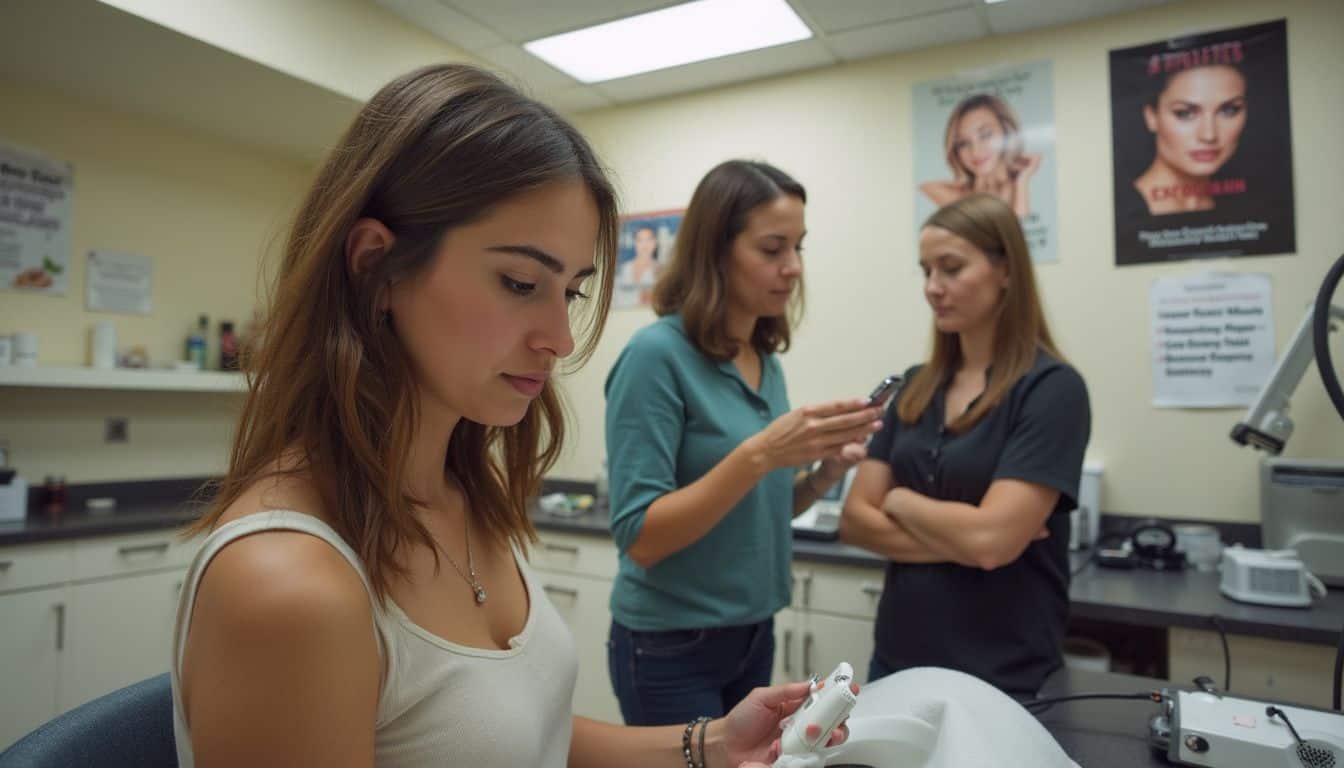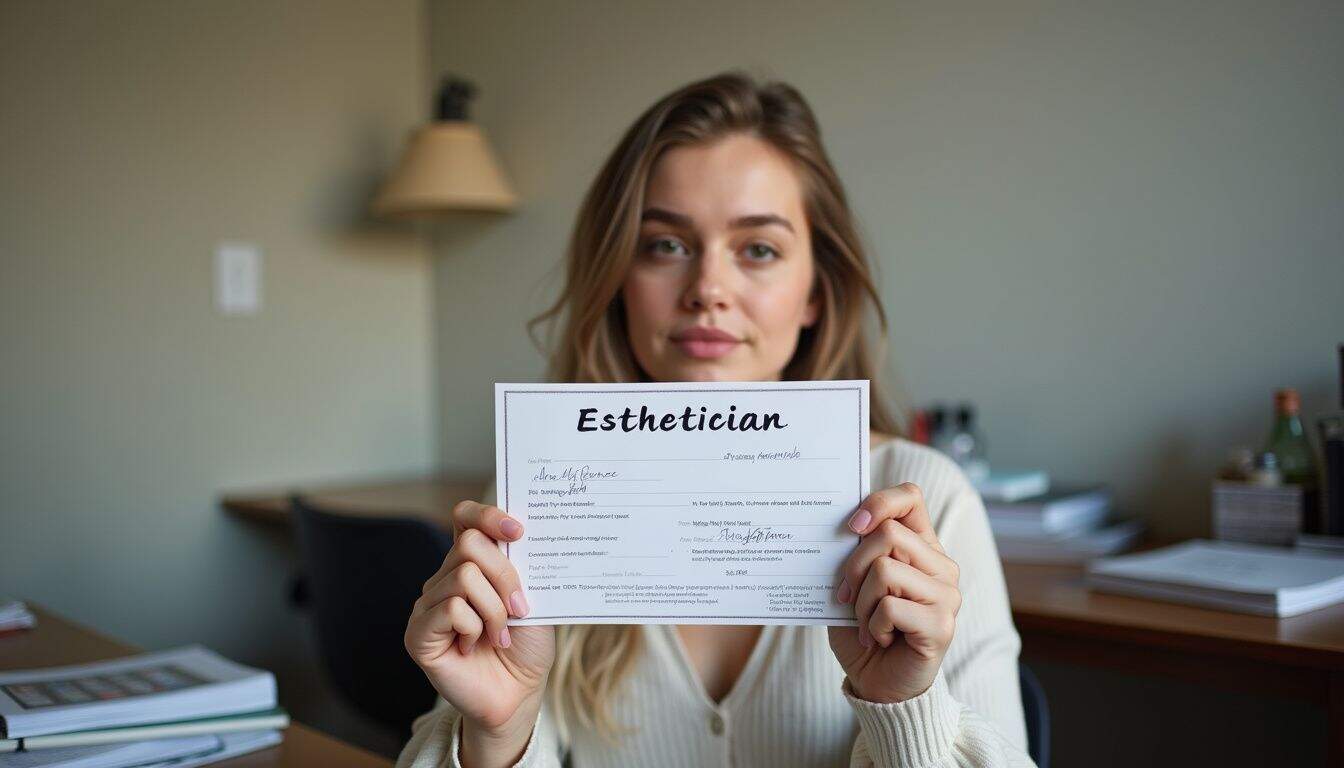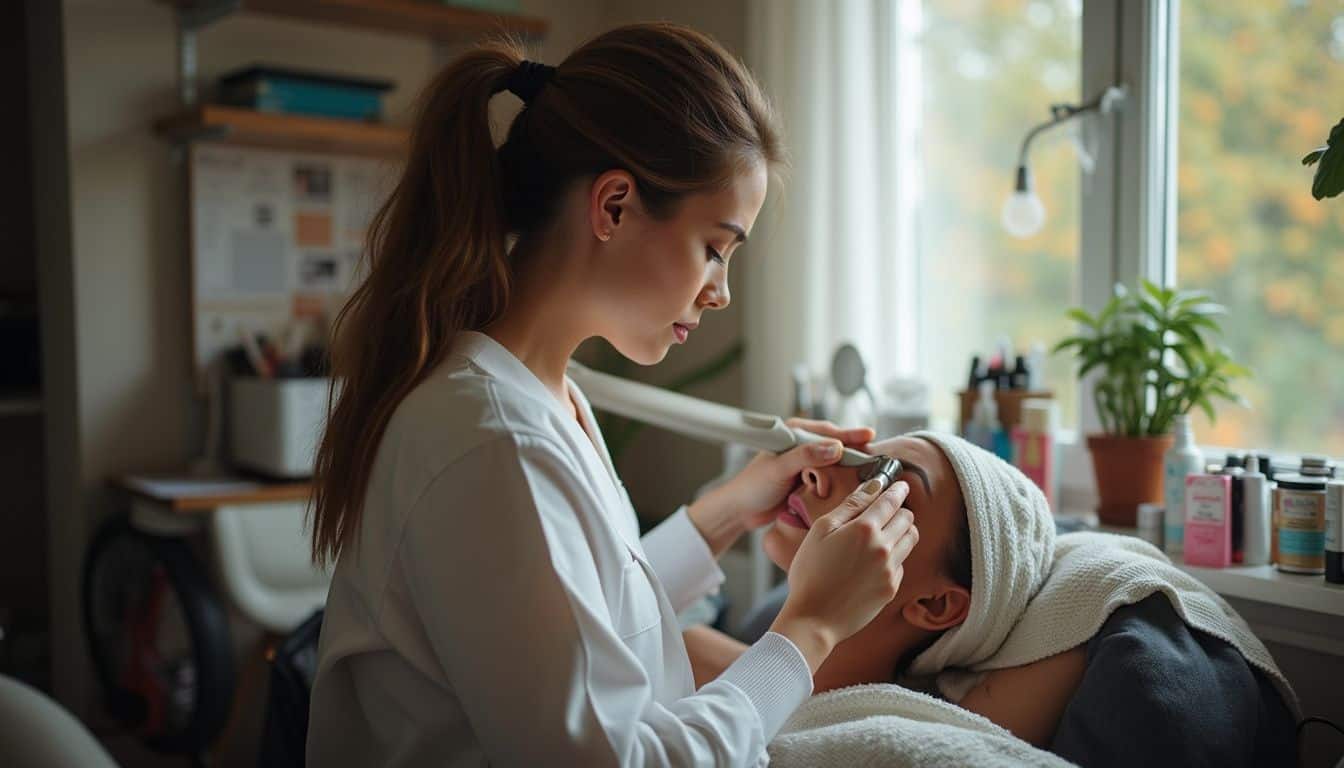Have you ever wondered how to start a career in skincare and aesthetics, but felt overwhelmed by all the different paths and requirements?
You’re not alone.
The great news is that the beauty and wellness industry is growing faster than ever, which means brand new doors for jobs are constantly opening. Whether you dream of performing transformative chemical peels or mastering advanced skincare treatments, there’s a place for you.
I’m going to walk you through 9 simple steps to find the right training, certifications, and real-world skills you need for success. Let’s make your path perfectly clear, together.
Key Takeaways
Complete 650 to 750 hours of hands-on training at an accredited beauty school and pass your state exams to earn your esthetician license.
Pursue advanced certifications like a Master Esthetician license, Oncology Esthetics training, or Laser Hair Removal Training to unlock more job opportunities in clinics and medical spas.
Build a strong portfolio with high-quality before-and-after photos, real client testimonials, and copies of your licenses; keep it updated online to attract new clients.
Leverage social media platforms like Instagram and TikTok to showcase your results, share helpful tips, host giveaways, and respond quickly to messages to grow your business.
The U.S. Bureau of Labor Statistics projects that jobs for skincare specialists are expected to grow 7% from 2024 to 2034, with new trends like laser treatments requiring ongoing learning and certification.
Table of Contents
What Is the Skincare and Aesthetics Profession?

Estheticians are the experts who blend hands-on skill with science to take care of skin health, boost well-being, and help people feel their absolute best. They provide a huge range of services, including facials, body treatments, chemical peels, and exfoliation methods like dermaplaning or microdermabrasion.
They also perform hair removal through waxing or advanced laser technology, using tools like yag lasers or co2 lasers. A huge part of the job is educating customers on daily skincare routines with the right products.
Medical estheticians often work in clinics and medical spas alongside dermatologists, plastic surgeons, or physician’s assistants. In these roles, they might assist doctors with injectable fillers like Botox or sclerotherapy to treat wrinkles and scars. This career path is booming, with the global medical spa market projected to grow from $18.88 billion in 2024 to $21.47 billion in 2025.
Spa settings are all about relaxation, think gentle massage therapy and explaining how an exfoliant removes dead skin cells. On the other hand, medical aesthetics gets more technical, sometimes involving care for patients recovering from surgery or battling cancer, all under board-certified supervision.
My first job involved prepping clients for microneedling at a busy dermatology office, and it taught me so much about why great communication skills are essential when explaining new beauty treatments. If you’re excited about a field that mixes medicine and surgery with beauty every day, you can explore entry-level training for aspiring aestheticians.
“Clients trust us because we listen while caring for their skin, each visit shapes our reputation.”
Educational and Training Requirements

Your journey starts with a comprehensive education from beauty schools or vocational schools. This is where you’ll practice real skills like exfoliate treatments, makeup application, and laser skin resurfacing while learning from industry experts.
What esthetician programs should I enroll in?
Starting your career in skincare means picking the right program. You need training that gives you real-world skills and prepares you to pass your state exams.
- Accredited Facial Skincare courses, like the 1-Day Facial Massage & Skincare Course, teach the basics quickly, giving you hands-on know-how from day one.
- VTCT Level 2 and Level 3 qualifications are highly respected in beauty schools and vocational schools; many insurance providers require them for coverage.
- The Beauty Academy offers classroom training for a variety of skills, including Lash & Brow, Nail Care, and Waxing, all featuring client testimonials to show proven results.
- Comprehensive esthetics programs that include at least 650 hours of study (usually 6 to 9 months full-time) are necessary to qualify for most state licensure exams. The average cost for these programs can range from $5,000 to $15,000.
- Online beginner classes with VTCT diplomas are a great option if you have a busy schedule. Many employers now recognize and accept digital learning certificates.
- Advanced training will cover medical esthetics, including dermal fillers, advanced makeup treatments, and the skills needed to work in dermatology offices or plastic surgery clinics.
- Look for training centers in major cities like Birmingham, London, or Manchester, as they often provide flexible scheduling options.
- Consider a program bundle that includes sales and digital marketing workshops. This will boost your proficiency in promoting your services on Instagram or TikTok.
- Programs with internships or mentorships from experienced practitioners help you build connections and learn how to use professional tools safely.
I started with an accredited facial diploma and then pursued advanced lash training once I was comfortable with clients. These programs gave me the confidence to talk with suppliers about new exfoliate products and helped my application stand out during my search for employment.
Which advanced certifications and specializations are worth pursuing?
If you want to truly shine in the skincare world, advanced certifications are the way to go. They open up exciting opportunities in medical esthetics, cosmetic treatments, and high-end wellness clinics.
- Master Esthetician License: This advanced license allows you to handle more complex skin issues. Many states require over 1,200 training hours for this prestigious title.
- Oncology Esthetics: This specialization trains you to provide safe and compassionate skincare for cancer patients. Hospitals and specialized clinics actively seek out professionals with this certification.
- Medical Esthetician Certification: This allows you to work directly with physicians or registered nurses. The curriculum covers noninvasive procedures and safety protocols set by the medical board.
- Certified Acne Specialist: These courses teach you how to manage challenging acne cases that go beyond standard facials. It’s a highly valued skill in many clinics.
- Chemical Peels Certification: This makes you an expert in advanced skin resurfacing. Salons and spas prioritize staff who can perform chemical peels safely and effectively.
- Laser Hair Removal Training: This covers the use of devices like yttrium aluminum garnet (YAG) lasers. This is a vital skill for anyone looking to work in medspas or dermatologist offices.
- Dermaplaning Certification: This sharpens your skills in manual exfoliation with a blade, a popular treatment that gives clients radiant skin with no downtime.
- Body Sculpting Masterclass: This teaches advanced contouring techniques like liposculpture. Many health care workers increase their salaries by adding liposuction alternatives to their service menu.
- Lymphatic Drainage Certificate: This shows you know specialized massage techniques to reduce swelling after surgery or other beauty treatments.
Many of these certifications are offered through reputable organizations like FAMA or as part of VTCT Level programs. Each path includes hands-on practice, in-depth theory, and state exams, giving you results worth sharing on your resume and social media.
How Do I Obtain Licensing and Certifications?

Getting your license is a non-negotiable step to becoming a professional in skincare and aesthetics. You need the right certifications to get hired and to legally offer your own services.
- First, you’ll need a high school diploma or GED. This is the baseline requirement in every state.
- Age is a factor. For example, in Texas, you must be at least 17 years old to take any exams or start your courses.
- You must complete 750 hours of training at an accredited beauty school, such as the American Academy of Aesthetics in Dallas. These hours cover skin care, facial treatments, sanitation, and even elements of aesthetic medicine.
- Accreditation is key. Choose schools with recognized programs to ensure your certification meets industry standards and is respected by employers and insurance companies.
- Once your training is complete, apply for your state license. You’ll need to provide records proving you finished all the required coursework.
- You will need to pass two state examinations: a written test on theory and a practical exam where you demonstrate your skills.
- In most states, like Texas, you can expect to renew your esthetician license every two years. This often requires completing continuing education classes to stay current.
- After licensing, consider specialized certifications, like medical aesthetics or liposculpting, if you want to work closely with medical professionals.
- If you’re interested in practicing in Florida, consider a school like Danik Beauty Academy. It is licensed by the Department of Education, ensuring its courses prepare you for the state’s exams.
I still remember the nerves before my practical exam, but all that hard work paid off. There’s nothing like seeing that “passed” notification after months of studying!
How Can I Gain Hands-On Experience?

It’s time to roll up your sleeves and dive in. Practicing with real clients and getting comfortable with tools for facial treatments and laser hair removal is how you’ll truly sharpen your skills. Wondering where to begin? Keep reading.
What internships and entry-level jobs are available?
Hands-on experience is everything in skincare and aesthetics. The good news is that many jobs let you learn while you earn.
- Internships at spas or salons allow you to shadow licensed cosmetologists and estheticians, giving you a front-row seat to professional client interactions.
- Entry-level roles like a skincare assistant or front desk support in a clinic can help you learn the daily operations up close.
- Medical offices often hire assistants to help medical aestheticians prepare treatment rooms and organize tools.
- Beauty brands frequently hire for entry-level positions like product testers or sales staff, which is a great way to build product knowledge quickly.
- Cosmetic counters in department stores need consultants to guide customers through makeup and skin routines.
- Graduates from reputable schools often find many job offers from salons, spas, and dermatologists looking for fresh talent. For instance, a school like Victory Career College reported a 95% job placement rate for its graduates in a recent year.
- Hair removal centers, like European Wax Center, are often hiring waxing or laser staff and sometimes offer on-the-job training.
- You can find internships on online job boards like Indeed or Glassdoor, as well as industry-specific sites from organizations like the American Association of Cosmetology Schools.
- Some plastic surgeons hire aides to help with patient preparation, offering a direct entry point into medical aesthetics clinics.
- Attending local networking events and open houses can help you meet hiring managers before positions are even posted publicly.
How do I find mentorship opportunities?
Finding the right mentor can truly accelerate your career in skincare. It can feel a little intimidating to reach out, but making strong connections can have a lasting impact.
- Attend industry events like trade shows or seminars to meet experienced estheticians. These events are perfect for asking questions about professional training.
- Connect with seasoned skincare pros on social media. Following them on Instagram or joining professional Facebook groups makes it easy to see their work and start a conversation.
- Join professional organizations like the American Med Spa Association (AmSpa) or the National Coalition of Estheticians. Members often get access to exclusive mentorship programs.
- Ask local beauty schools and clinics about their mentorship programs. Many schools have partnerships with local spas that welcome newcomers for paid opportunities.
- Offer to shadow an established practitioner in a clinic or medspa. This provides an invaluable, up-close look at advanced procedures and business operations.
- Consider signing up for paid mentorship sessions with estheticians who hold advanced certifications. Many mentors offer one-on-one coaching.
- Network at community wellness fairs in your city. You never know who you might meet, especially someone with an entrepreneurial spirit who loves to teach.
- Build a strong online presence that showcases your passion for skincare innovations. Share before-and-after photos from your practice sessions or write about new treatments.
- Don’t be afraid to reach out to local dermatologists or medspa owners directly. A simple, professional email introducing yourself could open a door.
How Do I Build a Professional Portfolio?
A great portfolio is your best tool for attracting clients because it visually demonstrates your skills. Strong photos, a clean design, and honest reviews will make your work shine.
- Take high-quality before-and-after photos of your work. Use good lighting, a clean background, and a steady hand to get the best shots.
- Organize your photos by service type, like facials or waxing. This makes it easy for potential clients to see your skills in the specific area they’re interested in.
- Include recent client testimonials to build trust. A heartfelt story from a happy client is incredibly powerful.
- Add copies of your esthetician license and any certificates from programs like the National Coalition of Estheticians Association (NCEA). Also, include badges for any advanced training.
- Keep the layout simple and clean. Use easy-to-read fonts and give your images plenty of space to breathe. A cluttered portfolio can be confusing.
- Only use sharp, clear images. Blurry or dark photos can make your work look unprofessional.
- Update your portfolio every few months with new services, photos, and feedback. This shows you’re actively growing in the skincare and aesthetics field.
- Create an online version using a simple website builder like Canva or Portfoliobox and share the link on your Instagram or LinkedIn profiles.
- Make sure your contact information is easy to find so booking an appointment with you is effortless.
What Are the Career Path Options in Skincare and Aesthetics?
The career options are incredibly diverse. You could work in cosmetic dermatology, a bustling beauty clinic, or even start your own freelance skincare business. Some women love the artistry of shaping brows with microblading, while others are passionate about using lasers to clear up acne scars.
What does a career in medical aesthetics involve?
A career in medical aesthetics means you’ll be performing skin treatments that require advanced skills and strict safety protocols. Medical estheticians often perform laser skin resurfacing, assist with dermal fillers, and help with Botox-type injections under a doctor’s supervision.
Your daily work will involve using high-tech devices in a clinical setting. As a Laser Technician, you’d operate machines for hair removal or scar reduction. An Aesthetic Nurse Injector specializes in administering injectables to smooth wrinkles or enhance facial features.
Medical estheticians need to stay current with new products and be diligent about hygiene, as state laws for these services vary. A key part of the job is collaborating with physicians to provide patients with post-treatment care advice.
According to the U.S. Bureau of Labor Statistics, the job outlook for skincare specialists is projected to grow much faster than average, with an expected 7% increase between 2024 and 2034.
If you enjoy blending science with beauty and helping women build their confidence, this could be the perfect path for you.
What services are offered in spa and salon settings?
While medical aesthetics focuses on clinical treatments, spa and salon services are all about bringing beauty and relaxation directly to the customer. Spa estheticians offer a wide range of services designed to pamper and rejuvenate.
Here’s a look at what you might offer:
- Facials and Skincare: This includes customized facials, exfoliation treatments like light peels, masks, and nourishing body wraps and scrubs.
- Lash and Brow Services: Specialists in this area tint, shape, and apply extensions to lashes and brows for an instant beauty boost.
- Makeup Artistry: Many estheticians use their deep knowledge of skincare to create beautiful makeup looks for special events.
- Nail Services: Nail technicians shape, paint, and care for nails, often incorporating creative nail art.
- Massage Therapy: Spas frequently offer treatments like deep-tissue massages to help clients relax and de-stress.
Some estheticians even go into teaching. In the UK, for example, a VTCT Level 3 in Education & Training is a common requirement to become an instructor. Many find these roles incredibly rewarding. You can check out more ideas for fun jobs that pay well if you’re looking for inspiration. Each service focuses on self-care, using simple tools and soothing products to make women feel refreshed and confident.
How Can I Develop Business and Marketing Skills?
Having amazing skincare skills is just one part of the equation. To succeed, you also need sharp business sense, because even the best facial in town won’t pay the bills on its own. It’s time to get creative with tools like Instagram and Canva to showcase your unique style and draw new clients to your door.
How do I promote my services on social media?
Social media is one of the most powerful tools for any woman in the skincare and aesthetics business. With quick posts, real results, and the right hashtags, you can build a loyal client base.
- Post compelling before-and-after photos on Instagram or TikTok to show potential clients the amazing results you can deliver.
- Share short video tutorials on Facebook Reels or TikTok. Teach simple skincare tips that women can try at home to build trust and authority.
- Ask your happiest clients for testimonials and feature them in your posts. This is a great way to ease the minds of new followers who might be nervous about booking.
- Use Instagram Stories and live streams to host real-time Q&A sessions. This direct engagement keeps your audience hooked and showcases your expertise.
- Run special promotions or giveaways for first-time clients. Announce them on Facebook and Instagram to quickly attract new faces.
- Collaborate with local hair salons or fitness trainers on content swaps. By tagging each other, you can both reach a wider audience of women interested in self-care.
- Create a consistent posting schedule. Plan out educational content, ingredient spotlights, and behind-the-scenes glimpses to keep your followers coming back for more. A scheduling tool like Later or Planoly can help you stay on track.
- Always respond quickly to comments and messages. This makes potential clients feel seen and valued.
How can I network within the beauty industry?
Building strong connections in the skincare and beauty world is key to discovering new opportunities and partnerships. A solid network can boost your reputation and open doors you never thought possible.
- Attend trade shows and beauty expos. Events like the International Esthetics, Cosmetics & Spa Conference (IECSC) are perfect for meeting people, exchanging business cards, and talking about your services.
- Participate in workshops offered by major brands like Dermalogica or PCA Skin to connect with other women in the field.
- Join Facebook groups for estheticians or skincare professionals. These communities are fantastic for sharing advice, job leads, and the latest treatment trends.
- Engage with industry leaders on Instagram. Commenting on posts from well-known experts like Renee Rouleau or Dr. Dennis Gross can get you noticed.
- Collaborate with local makeup artists or hair stylists. Many client referrals come from these types of partnerships.
- Volunteer at major fashion events, like New York Fashion Week. You never know when you’ll meet influential dermatologists or celebrity estheticians backstage.
- Visit local salons and spas in person. Introduce yourself and ask if they need freelance help during their busy seasons.
- Sit in on panel discussions at conferences. Asking thoughtful questions during the Q&A is a great way to catch the attention of established professionals.
- Always follow up after you meet someone new. A quick “nice to meet you” email helps them remember you.
- Keep an eye on beauty news outlets like Allure or The Business of Fashion to stay informed about important industry gatherings.
How Will the Skincare and Aesthetics Profession Change in 2025?
The world of skincare and aesthetics is always changing, and 2025 is shaping up to be an exciting year. Trends on social media and celebrity endorsements will continue to drive more people to try new treatments, including a growing number of men looking for effective, low-downtime options.
The U.S. Bureau of Labor Statistics predicts that the demand for skincare specialists will grow by 10%, a rate much faster than many other jobs. This growth is fueled by new technology and a greater focus on overall wellness.
Laser skin treatments are becoming increasingly common, and we’re seeing more collaboration between doctors and estheticians on advanced procedures. In my own experience, clients are always asking about the latest tech they see on Instagram or TikTok.
One of the biggest trends is the rise of AI-powered diagnostics. Tools like the Muilli AI Dermascope or Vichy’s SkinConsult AI can analyze a client’s skin in incredible detail, allowing for truly personalized treatment plans. This technology is changing how we approach skincare, moving from general advice to data-driven solutions. As schools like ISSNMT celebrate 40 years, it’s clear how much training has evolved, with online classes making education more accessible than ever.
People Also Ask
What education do I need to start a career in skincare and aesthetics?
You’ll need a high school diploma or GED to enroll in an accredited esthetics or cosmetology program. These programs cover skin science, safety protocols, and hands-on treatments like facials and waxing.
How long does it take to become a licensed skincare specialist?
Most esthetician programs require between 600 and 750 hours of training, which can take about six to nine months to complete if you attend full-time. After graduating, you must pass your state’s licensing exam, like the NIC National Examination, to become officially licensed.
Do I need work experience before getting my first job in this field?
Many new graduates get their start at franchise locations like European Wax Center or Massage Envy, which often provide additional training.
What steps help me stand out when starting my career in skincare and aesthetics?
Earn advanced certifications in high-demand services like chemical peels, laser hair removal, or microneedling to increase your value to employers. Building a professional social media presence to showcase your skills can also attract both clients and job opportunities.
References
http://www.milady.com/career-of-possibilities/how-to-become-an-esthetician (2025-04-18)
https://www.tealhq.com/certifications/esthetician
https://www.indeed.com/career-advice/finding-a-job/how-to-become-an-esthetician-in-texas
https://www.tricociuniversity.edu/programs/esthetics/how-to-get-an-esthetician-certification/
https://www.skinclique.com/blog/article/hands-on-aesthetic-experience (2025-03-27)
https://iicad.org/career-paths-in-aesthetics-choosing-the-right-specialization-2/
https://www.hjemaesthetics.com/blog/starting-your-career-in-aesthetics-a-step-by-step-guide (2024-12-15)
https://drdahabra.com/how-to-find-an-aesthetics-mentor/ (2025-04-19)
https://wrapturebeautyacademy.com/creating-a-professional-esthetician-portfolio/ (2024-05-31)
https://www.tspasanjose.com/blog/tips-for-building-a-successful-skincare-portfolio/ (2024-09-23)
https://aaams.net/blog/roles-in-med-aesthetics-industry/
https://pmc.ncbi.nlm.nih.gov/articles/PMC10231726/
https://www.adrians.edu/blog/9-careers-you-can-have-as-an-esthetician/
https://www.theskininstitute.org/career-path-for-aspiring-estheticians/
https://www.tspaaltoona.com/blog/why-networking-in-the-beauty-industry-is-essential-for-success/ (2024-11-11)
https://www.chairstoprofits.com/articles/how-to-network-beauty-industry/
